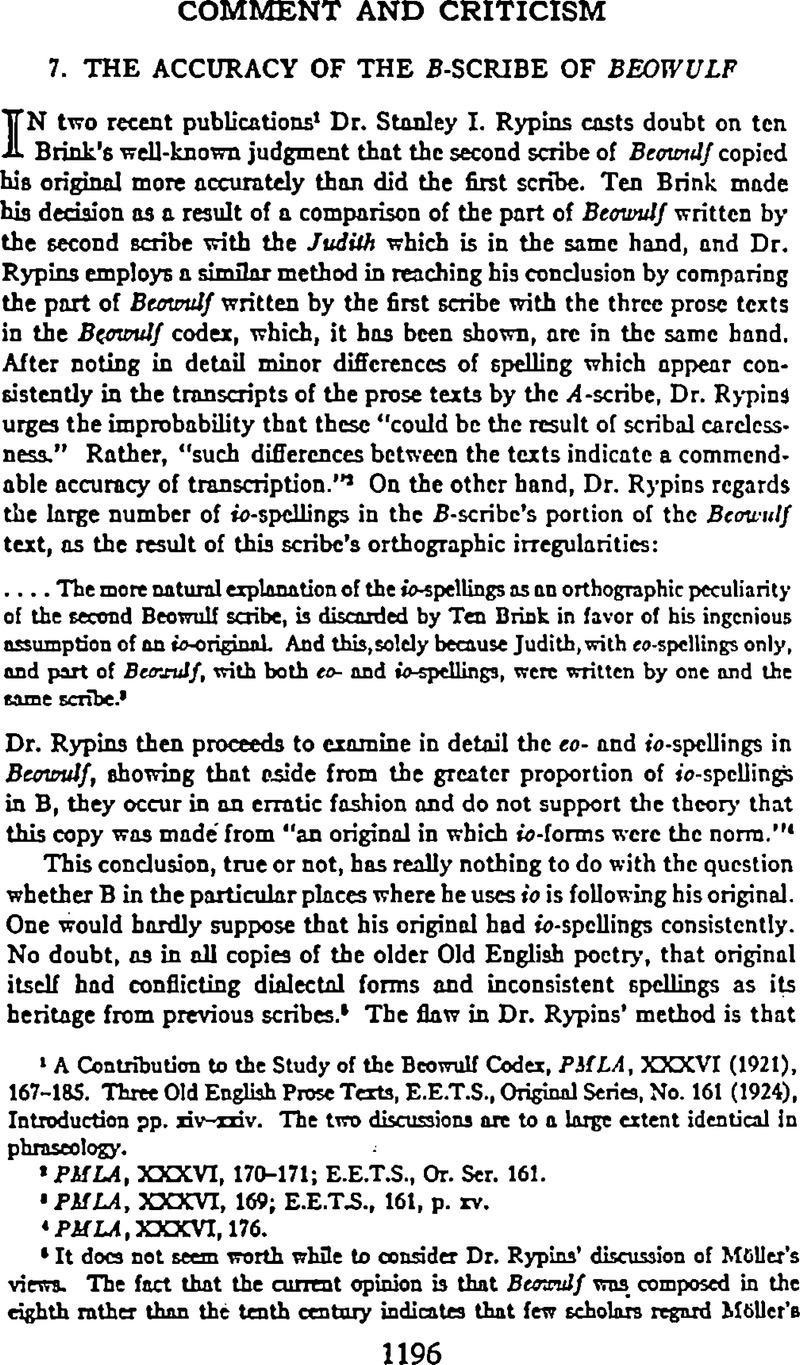Article contents
7. The Accuracy of the B-Scribe of Beowulf
Published online by Cambridge University Press: 23 February 2021
Abstract

- Type
- Comment and Criticism
- Information
- Copyright
- Copyright © Modern Language Association of America, 1928
References
page 1196 note 1 A Contribution to the Study of the Beowulf Codex, MLA, XXXVI (1921), 167-185. Three Old English Prose Texts, E.E.T.S., Original Series, No. 161 (1924), Introduction pp. xiv-xxiv. The two discussions are to a large extent identical in phraseology.
page 1196 note 2 PMLA, XXXVI, 170-171; E.E.T.S., Or. Ser. 161.
page 1196 note 3 PMLA, XXXVI 169; E.E.T.S., 161, p. xv.
page 1196 note 4 PMLA, XXXVI, 176.
page 1196 note 5 It does not seem worth while to consider Dr. Rypins' discussion of Möller's views. The fact that the current opinion is that Beowulf was composed in the eighth rather than the tenth century indicates that few scholars regard Möller's theory as probable. (See Klaeber's Beowulf, p. cx ff.) Hence it is natural to suppose that the poem had passed through the hands of many scribes before it reached the “original” which scribe copied. (Klaeber, op. cit., p. xc.)
page 1197 note 6 PMLA, pp. 175-176; Three Prose Texts, p. xx.
page 1197 note 7 Ibid.
page 1198 note 8 In other less striking deuils shows more care than A. For instance, he never uses the form scada, but always has ea. Similarly in words in which the combination weo occurs (aside from worold which occurs throughout the poem, and wordig, 1. 1972) he never writes wu, as A does in swurd, ll. 539, 890; wurden, l. 807; gewurpad, l. 1645; hworfan, l. 1728; swurd, l. 1901. On the other hand, has a personal habit of spelling sweord as swyrd, ll. 2610, 2987, 3048; Judith, ll. 230, 318, 264, 302, 322 (Klaeber, op. cit., p. xciii). If one reads with some care the section in Klaeber's edition dealing with language, pp. lxii ff., one will form the impression that in general where both A and have late forms, A has a larger proportion than B. For instance, under 18.1 Klaeber cites eleven cases of O.E. -um weakened to -un, -on, -an from A and only three in B.
In all these cases (except the spelling swyrd) is using older forms in Beowulf, later forms in Judith. Hence Dr. Rypins' suggestion, “In Beowulf. the second scribe was merely finishing up another man's work, and may well have been careless about it” (PMLA, p. 176) cannot apply.
page 1198 note 9 One of Dr. Rypins' arguments is as follows: “. It so happens, however. that precisely those conditions which ten Brink advances in support of the accuracy of the second Beowulf scribe, are duplicated in the work of scribe number one. The Christophorus fragment, copied, it will be remembered, by him who transcribed the first 1931 lines of Beowulf, is like Judith, characterized by the total absence of io-forms. Obviously, then, any argument in favor of the accuracy of the second scribe which ten Brink develops from the consistent use of eo-spellings in Judith, may with equal propriety be derived from the evidence of the Christophorus fragment in support of the accuracy of the first scribe.” (PMLA, p. 173; Three Prose Texts, p. xviii.) Of course the conditions are not parallel. Indeed the facts cited concerning A confirm ten Brink's general position; that is, A preferred eo to io: be wrote Christophorus with eo only; he changed many io's in Beowulf to eo's.
page 1198 note 10 PMLA, p. 185.
- 1
- Cited by


